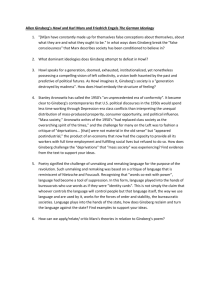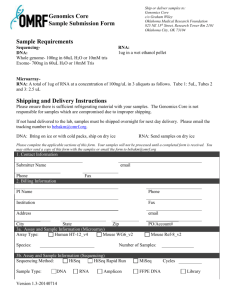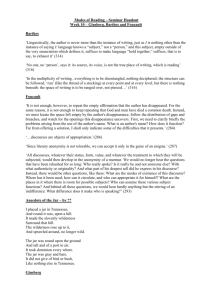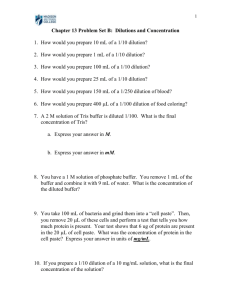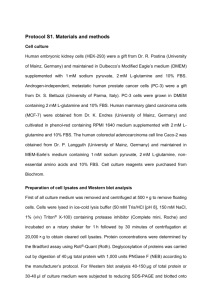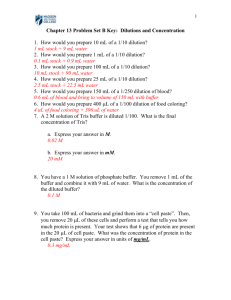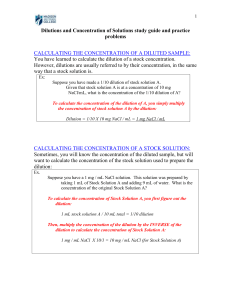Alldred et al., p. Supplemental Text Supplemental Methods Tissue
advertisement
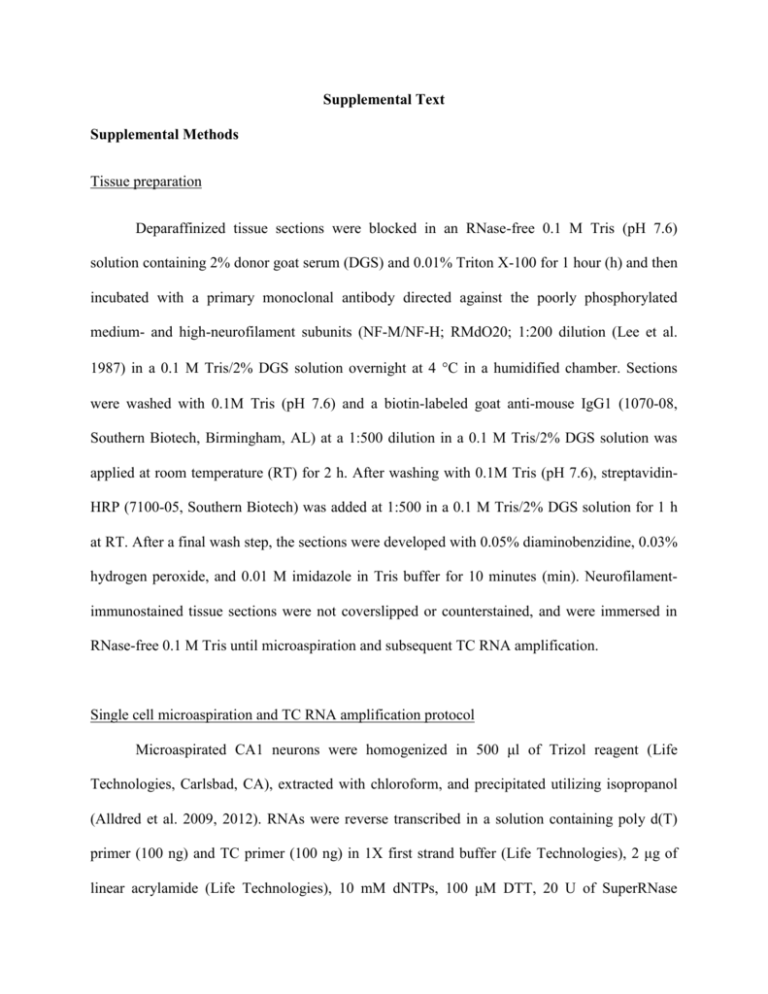
Supplemental Text
Supplemental Methods
Tissue preparation
Deparaffinized tissue sections were blocked in an RNase-free 0.1 M Tris (pH 7.6)
solution containing 2% donor goat serum (DGS) and 0.01% Triton X-100 for 1 hour (h) and then
incubated with a primary monoclonal antibody directed against the poorly phosphorylated
medium- and high-neurofilament subunits (NF-M/NF-H; RMdO20; 1:200 dilution (Lee et al.
1987) in a 0.1 M Tris/2% DGS solution overnight at 4 C in a humidified chamber. Sections
were washed with 0.1M Tris (pH 7.6) and a biotin-labeled goat anti-mouse IgG1 (1070-08,
Southern Biotech, Birmingham, AL) at a 1:500 dilution in a 0.1 M Tris/2% DGS solution was
applied at room temperature (RT) for 2 h. After washing with 0.1M Tris (pH 7.6), streptavidinHRP (7100-05, Southern Biotech) was added at 1:500 in a 0.1 M Tris/2% DGS solution for 1 h
at RT. After a final wash step, the sections were developed with 0.05% diaminobenzidine, 0.03%
hydrogen peroxide, and 0.01 M imidazole in Tris buffer for 10 minutes (min). Neurofilamentimmunostained tissue sections were not coverslipped or counterstained, and were immersed in
RNase-free 0.1 M Tris until microaspiration and subsequent TC RNA amplification.
Single cell microaspiration and TC RNA amplification protocol
Microaspirated CA1 neurons were homogenized in 500 μl of Trizol reagent (Life
Technologies, Carlsbad, CA), extracted with chloroform, and precipitated utilizing isopropanol
(Alldred et al. 2009, 2012). RNAs were reverse transcribed in a solution containing poly d(T)
primer (100 ng) and TC primer (100 ng) in 1X first strand buffer (Life Technologies), 2 μg of
linear acrylamide (Life Technologies), 10 mM dNTPs, 100 μM DTT, 20 U of SuperRNase
Alldred et al., p. 2
Inhibitor (Life Technologies), and 200 U of reverse transcriptase (Superscript III, Life
Technologies). Single-stranded cDNAs were then subjected to RNase H digestion and reannealing of the primers to generate cDNAs with double-stranded regions at the primer
interfaces. Single stranded cDNAs were digested by adding the following and then placed in a
thermal cycler: 10 mM Tris (pH 8.3), 50 mM KCl, 1.5 mM MgCl2, and 10 U RNase H (Life
Technologies) in a final volume of 100 μl. RNase H digestion step at 37 ºC, 30 min; denaturation
step 95 ºC, 3 min; primer re-annealing step 60 ºC, 5 min (Che and Ginsberg 2004). Samples were
purified by Vivaspin 500 columns, 10,000 MWCO PES (Sartorius Stedim Biotech, Goettingen,
Germany). cDNA was diluted with 350 μl of 18.2 mega Ohm RNase-free water and transferred
to column reservoirs. The columns were then spun at 13,000 x g for 10 min. The cDNA was
recovered and equilibrated to 13 μl with 18.2 mega Ohm RNase-free water. Hybridization probes
were synthesized by in vitro transcription using 33P incorporation in 40 mM Tris (pH 7.5), 6 mM
MgCl2, 10 mM NaCl, 2 mM spermidine, 10 mM DTT, 2.5 mM ATP, GTP and CTP, 100 μM of
cold UTP, 20 U of SuperRNase Inhibitor, 2 KU of T7 RNA polymerase (Epicentre, Madison,
WI), and 120 μCi of 33P -UTP (Perkin-Elmer, Boston, MA) (Ginsberg and Che 2002; Ginsberg
2005, 2008). The reaction was performed at 37 °C for 4 h. Radiolabeled TC RNA probes were
hybridized to custom-designed cDNA arrays without further purification.
Microarray hybridization
Arrays were prehybridized (4 h) and hybridized (16 h) in a solution consisting of 6X
saline–sodium phosphate–ethylenediaminetetraacetic acid (SSPE), 5X Denhardt's solution, 50%
formamide, 0.1% sodium dodecyl sulfate (SDS), and denatured salmon sperm DNA (200 μg/ml)
at 42 °C in a rotisserie oven (Che and Ginsberg 2004; Alldred et al. 2008, 2009, 2012; Ginsberg
Alldred et al., p. 3
2008). Following hybridization, arrays were washed sequentially in 2X SSC/0.1% SDS, 1X
SSC/0.1% SDS and 0.5X SSC/0.1% SDS for 15 min each at 37 °C. Arrays were placed in a
phosphor screen for 24 h and developed on a phosphor imager (GE Healthcare, Piscataway, NJ).
All array phosphor images were adjusted to the same brightness and contrast levels for data
acquisition and analysis.
Hybridization signal intensity was determined via ImageQuant TL (GE Healthcare).
Expression levels of TC amplified RNA bound to each linearized cDNA (576 cDNAs/ESTs on
the array platform) minus background was expressed as a percentage of the total hybridization
signal intensity of the array (a global normalization approach).
Immunoblot analysis
Homogenization of frozen hippocampal dissections was done in a 20 mM Tris-HCl (pH
7.4) buffer containing 10% (w/v) sucrose, 1 mM ethylenediaminetetraacetic acid (EDTA), 5 mM
ethylene glycol-bis (b-aminoethylether)-N,N,N',N'-tetra-acetic acid (EGTA), 2 mg/ml of the
following: (aprotinin, leupeptin, and chymostatin), 1 mg/ml of the following: {pepstatin A,
antipain, benzamidine, and phenylmethylsulfonyl fluoride (PMSF)}, 100 μg/ml of the following:
{soybean trypsin inhibitor, Na-p-tosyl-L-lysine chloromethyl ketone (TLCK), and N-tosyl-Lphenylalanine chloromethyl ketone (TPCK)}, 1 mM of the following: (sodium fluoride and
sodium orthovanadate) and centrifuged as described previously (Counts et al. 2004; Ginsberg
2005b; Ginsberg et al. 2010). All protease inhibitors were purchased from Sigma (St. Louis
MO). Identical amounts of homogenates (10 μg) were loaded into a gel electrophoresis
apparatus, subjected to sodium dodecyl sulfate-polyacrylamide gel electrophoresis (SDS-PAGE;
Alldred et al., p. 4
4-15% gradient acrylamide gels; Bio-Rad), and transferred to nitrocellulose by electroblotting
(Mini Transblot, Bio-Rad). Nitrocellulose membranes were blocked in blocking buffer (LiCor,
Lincoln, NE) for 1 h at 4 °C prior to being incubated with antibodies directed against GRIA1
(06-306; rabbit polyclonal; EMD Millipore, Billerica, MA; 1:1,000 dilution), GRIA2/3 (06-307;
rabbit polyclonal; EMD Millipore; 1:1,000 dilution), TrkB (#610102; purified mouse polyclonal;
BD Biosciences, San Jose, CA; 1:1,000 dilution), TrkC (#3376S; rabbit monoclonal; Cell
Signaling Technology, Danvers, MA; 1:1000 dilution), NTF3 (PA514861; rabbit polyclonal;
Thermo Scientific, Philadelphia, PA; 1:1000 dilution), BDNF (SC-546; rabbit polyclonal; Santa
Cruz Biotechnology, Dallas, TX, 1:1000 dilution), APP (gift of Paul Mathews, NKI/NYU
Langone Medical Center, 1:1000 dilution) or β-tubulin (TUBB; mouse monoclonal; T-5293;
Sigma, 1:1,000 dilution) in blocking buffer overnight at 4 °C. Membranes were developed with
affinity–purified secondary antibodies conjugated to IRDye 800 (Rockland Immunochemicals,
Gilbertsville, PA) and visualized using an infrared detection system (Odyssey, LiCor, Lincoln,
ME). Immunoblots were quantified by densitometric software supplied with the instrument.
Signal intensity of immunoreactive bands was normalized to TUBB immunoreactivity for each
assay.
The two mouse genotypes were compared with respect to the following proteins of
interest: GRIA1, GRIA2/3, TrkB (including TrkB-FL & TrkB-T1), APP, BDNF (including proBDNF and mature BDNF), TrkC (including TrkC-FL & TrkC-T1), and NTF3. Each protein
measure was modeled as a function of mouse genotype, using mixed effects models with random
mouse effect to account for the correlation between repeated assays on the same mouse
(McCulloch et al. 2008). To control for the potential effects of age and gender, terms for age,
gender, their interactions with mouse type and the 3-way interaction age-gender-phenotype were
Alldred et al., p. 5
included in the initial model. Backward elimination procedure was used to exclude from the
model any non-significant interaction terms. In none of the models were any interactions terms
significant, therefore all inferences were based on models with only main effects for genotype,
age and gender. This was done by modeling the outcome (gene expression of proteins) as a
function of mouse genotype controlling for gender and age.
Alldred et al., p. 6
References
Alldred MJ, Che S, Ginsberg SD (2009) Terminal continuation (TC) RNA amplification without
second strand synthesis. J Neurosci Meth 177:381–385.
Alldred MJ, Che S, Ginsberg SD (2008) Terminal Continuation (TC) RNA amplification enables
expression profiling using minute RNA input obtained from mouse brain. Int J Mol Sci
9:2091–2104.
Alldred MJ, Duff KE, Ginsberg SD (2012) Microarray analysis of CA1 pyramidal neurons in a
mouse model of tauopathy reveals progressive synaptic dysfunction. Neurobiol Dis 45:751–
762.
Che S, Ginsberg SD (2004) Amplification of RNA transcripts using terminal continuation. Lab
Invest 84:131-137.
Counts SE, Nadeem M, Wuu J, et al. (2004) Reduction of cortical TrkA but not p75(NTR) protein
in early-stage Alzheimer’s disease. Ann Neurol 56:520–531.
Ginsberg SD (2005a) Glutamatergic neurotransmission expression profiling in the mouse
hippocampus after perforant-path transection. Am J Geriatr Pyschiatry 13:1052–1061.
Ginsberg SD (2005b) RNA amplification strategies for small sample populations. Methods
37:229–237.
Ginsberg SD (2008) Transcriptional profiling of small samples in the central nervous system.
Methods Mol Biol 439:147–158.
Ginsberg SD, Alldred MJ, Counts SE, et al. (2010) Microarray analysis of hippocampal CA1
neurons implicates early endosomal dysfunction during Alzheimer’s disease progression.
Biol Psychiatry 68:885–893.
Ginsberg SD, Che S (2002) RNA amplification in brain tissues. Neurochem Res 27:981–992.
Lee VM, Carden MJ, Schlaepfer WW, Trojanowski JQ (1987) Monoclonal antibodies
distinguish several differentially phosphorylated states of the two largest rat neurofilament
subunits (NF-H and NF-M) and demonstrate their existence in the normal nervous system
of adult rats. J Neurosci 7:3474–3488.
McCulloch CE, Searle SR, Neuhaus JM (2008) Generalized, Linear, and Mixed Models, Second
Edition. John Wiley: New York
Alldred et al., p. 7
Figure Legends
Supplemental Figure 1: Relatively few GABAergic neurotransmission marker changes are found
in aged Ts65Dn mice relative to age-matched 2N littermates in CA1 pyramidal neurons.
(A) Expression profile levels in representative GABA-A receptor subunits and GAD enzymes.
(B) Expression levels of select GABA transporters. GABA-A beta 1 subunit (GABRB1) and
GABA transporter 4 (SLC6A11) show significant changes in gene expression (***p<0.001).
GABA-A receptor subunits alpha 1 (GABRA1) and delta (GABRD) also show trend level
changes (0.02<p<0.05).
Alldred et al., p. 8
Supplemental Table S1
Trend level (non-adjusted p-value) changes in CA1 pyramidal neuron gene expression via
microarray analysis (0.02<p<0.05)
Gene abbreviation
Gene name
Direction of Change
+
CALB2
calretinin
CAMK2A
calcium/calmodulin-dependent protein kinase II alpha
CAPNS1
µ calpain small subunit 1
CBR3
carbonyl reductase 3
CHMR5
muscarinic cholinergic receptor 5
CHRNB4
nicotinic acetylcholine receptor beta 4
CLCN4
chloride channel 4
CLCN5
chloride channel 5
CLCN7
chloride channel 7
DBH
dopamine beta-hydroxylase
DDC
dopa decarboxylase (aromatic L-amino acid decarboxylase)
DPP10
dipeptidylpeptidase 10
DXH9
RNA helicase RIG-1
EEA1
ERCC1
early endosome antigen 1
embryonic lethal, abnormal vision, Drosophila-like 1
(Hu antigen R)
embryonic lethal, abnormal vision, Drosophila-like 2
(Hu antigen B)
excision repair cross-complementing rodent repair deficiency
complementation group 1
FOSLR/FOSL2
fos-related antigen 2 (FRA2)
GABRA1
gamma-aminobutyric acid (GABA) A receptor alpha 1
GABRD
gamma-aminobutyric acid (GABA) A receptor delta
GFAP
glial fibrillary acidic protein
GRIK3
kainate receptor 3
ITGA4
Integrin alpha 4
ELAVL1
ELAVL2
+
+
+
+
+
+
+
Alldred et al., p. 9
KNS2
kinesin 2
MAP1LC3A
microtubule-associated protein 1 light chain 3 alpha (LC3)
MAPT3
microtubule-associated protein tau 3R1N
MAPT4
microtubule-associated protein tau 4R1N
NOS1
nitric oxide synthase 1 (neuronal)
NR4A2
nuclear receptor subfamily 4 group A member 2; NURR1
NR4A3
nuclear receptor subfamily 4 group A member 3; NOR-1
NSF
N-ethylmaleimide-sensitive factor
PAM
peptidylglycine alpha-amidating monooxygenase
PFKL
Phosphofructokinase liver B-type
PPP1CB
protein phosphatase 1 catalytic subunit beta
PPP3CB
protein phosphatase 3 catalytic subunit beta; calcineurin A beta
PRKCB1
protein kinase C beta-I
PRNP
prion protein PrP
PTGS2
prostaglandin-endoperoxide synthase 2; COX-2
RAP1B
RAP1B, member of RAS oncogene family
RGS12
regulator of G-protein signalling 12
RGS16
SLC1A3
regulator of G-protein signalling 16
solute carrier family 18 member 3
vesicular acetylcholine transporter 1 (VACHT1)
solute carrier family 1 member 1 (neuronal high affinity
glutamate transporter EAAT3)
solute carrier family 1 member 3 (glial high affinity glutamate
transporter EAAT1)
STX4A
syntaxin 4A
SUV39H1
suppressor of variegation 3-9 homolog 1
SYT1
synaptotagmin I
USP1
ubiquitin specific protease 1
SLC18A3
SLC1A1
+
+
+
+
+
+
+
+
+
